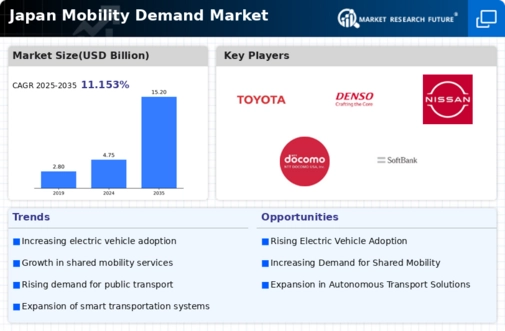Government Initiatives and Policies
Government initiatives play a crucial role in shaping the mobility demand market in Japan. The Japanese government has implemented various policies aimed at promoting sustainable transportation solutions. For instance, the introduction of subsidies for electric vehicles (EVs) and investments in public transport infrastructure are indicative of a strategic push towards greener mobility. In 2025, the government aims to increase the share of EVs to 20% of all new vehicle sales, which could significantly impact the mobility demand market. These policies not only encourage the adoption of cleaner technologies but also stimulate the development of supporting infrastructure, such as charging stations, thereby enhancing the overall mobility ecosystem.
Urbanization and Population Density
The increasing urbanization in Japan is a pivotal driver for the mobility demand market. As urban areas expand, the population density rises, leading to heightened demand for efficient transportation solutions. In 2025, approximately 91% of Japan's population resides in urban areas, which necessitates innovative mobility options to alleviate congestion. This urban-centric lifestyle fosters a shift towards public transportation and shared mobility services, as individuals seek alternatives to personal vehicle ownership. The market is likely to see a surge in demand for integrated transport systems that cater to the needs of densely populated cities, thereby enhancing accessibility and reducing travel times.
Aging Population and Accessibility Needs
Japan's aging population presents unique challenges and opportunities for the mobility demand market. With approximately 28% of the population aged 65 and older in 2025, there is an increasing need for accessible transportation solutions. This demographic shift necessitates the development of services that cater to the mobility needs of seniors, such as specialized public transport options and ride-sharing services designed for ease of use. The mobility demand market is likely to evolve to accommodate these accessibility requirements, fostering inclusivity and ensuring that all segments of the population can navigate urban spaces effectively. This focus on accessibility may also drive innovation in vehicle design and service delivery.
Environmental Concerns and Sustainability
Environmental concerns are increasingly influencing consumer behavior in Japan, thereby impacting the mobility demand market. As awareness of climate change and pollution rises, there is a growing preference for sustainable transportation options. In 2025, surveys indicate that over 70% of Japanese consumers prioritize eco-friendly modes of transport, such as public transit and electric vehicles. This shift in consumer sentiment is prompting companies to innovate and offer greener alternatives, which could lead to a significant transformation in the mobility demand market. The emphasis on sustainability not only aligns with global trends but also reflects a cultural shift towards responsible consumption and environmental stewardship.
Technological Advancements in Transportation
Technological advancements are transforming the mobility demand market in Japan. Innovations such as autonomous vehicles, smart traffic management systems, and mobile applications for ride-sharing are reshaping how individuals navigate urban environments. In 2025, it is estimated that the adoption of autonomous vehicles could account for up to 15% of the total vehicle fleet, indicating a shift towards more efficient and safer transportation options. These technologies enhance the user experience by providing real-time information and optimizing routes, which is likely to increase the attractiveness of shared mobility services. Consequently, the mobility demand market is poised for growth as these advancements become more integrated into daily commuting.

















Leave a Comment